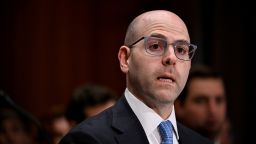Business
Fed’s New Governor Stephen Miran Advocates for Aggressive Rate Cuts

The Federal Reserve has welcomed its newest governor, Stephen Miran, who brings an unorthodox viewpoint on the US economy, challenging conventional monetary policy strategies. Appointed by President Donald Trump in September 2019, Miran has quickly made a name for himself by dissenting from the majority opinion of his fellow Fed officials during his initial meetings.
During the Fed’s October policy meeting, Miran opposed the decision to lower interest rates by a quarter point, advocating instead for a more substantial half-point cut, a stance he had also taken in September. His rapid rise in the Fed’s ranks has been marked by a series of public engagements—over a dozen within his first month—while most of his colleagues typically limit their appearances.
Miran aligns himself closely with Trump’s economic philosophy, frequently calling for significant interest rate reductions. He argues that current borrowing costs are placing undue pressure on the economy and anticipates “substantial disinflation” ahead, characterizing his views as “out of consensus.” In a recent interview with Yahoo Finance, he reiterated his belief that the Fed should act decisively to address these economic pressures.
Many in the economic community remain uncertain about Miran’s viewpoints. David Seif, chief economist for developed markets at Nomura, remarked, “I certainly wouldn’t characterize anything that he’s saying as ridiculous. It’s more of a debate on the inputs that he’s putting into his economic modeling, which are controversial.” He added that only time will clarify the validity of Miran’s predictions.
Miran’s rationale for advocating aggressive rate cuts is influenced by his interpretation of Trump’s economic policies and a belief that the administration’s tariffs will not lead to inflationary pressures. In his inaugural speech as a Fed governor, he discussed how these policies might lower the “neutral rate of interest,” a theoretical benchmark where borrowing costs neither stimulate nor hinder economic growth.
He cited Trump’s stringent immigration policies, recent tax reforms, and tariffs as factors that necessitate a more accommodating monetary policy. Miran has warned that maintaining tight policy for prolonged periods could push the economy toward recession, stating, “I don’t see a reason to run that risk if I’m not concerned about inflation on the upside,” in an interview with The New York Times published on November 1.
Additionally, he has suggested that ongoing mass deportations could relieve pressure on the housing market, leading to further reductions in interest rates and contributing to disinflation. His optimism regarding tariffs’ economic impact has also drawn scrutiny.
Despite having earned a PhD in economics from Harvard University, Miran’s ideas have faced criticism. Former Treasury Secretary Larry Summers described Miran’s debut speech as “analytically weak” and suggested that the case for substantial interest rate cuts is less convincing than he had anticipated.
Some Wall Street economists have echoed these sentiments. Michael Feroli, chief US economist at JPMorgan, indicated in a client note that they find many of Miran’s arguments questionable and unpersuasive.
Miran’s distinct economic perspective has not garnered widespread support among his peers on the Federal Reserve’s rate-setting committee. Similar to other Trump appointees, he acknowledges the risks posed by a weak labor market but diverges from the consensus regarding the neutral rate.
In a recent address, Fed Governor Lisa Cook subtly countered Miran’s views on immigration’s relationship with housing inflation, stating, “I think that’s the major role that I see in immigration policy,” emphasizing its impact on the labor market rather than economic inflation.
As the Federal Reserve navigates complex economic challenges, Miran’s unyielding stance on rate cuts will continue to spark debate and scrutiny within economic circles. His ability to influence policy and gain traction among his colleagues remains to be seen, and the coming months will be critical in determining the impact of his perspectives on the Federal Reserve’s direction.
-

 Science3 weeks ago
Science3 weeks agoInventor Achieves Breakthrough with 2 Billion FPS Laser Video
-

 Health4 weeks ago
Health4 weeks agoCommunity Unites for 7th Annual Into the Light Walk for Mental Health
-

 Top Stories4 weeks ago
Top Stories4 weeks agoCharlie Sheen’s New Romance: ‘Glowing’ with Younger Partner
-

 Entertainment4 weeks ago
Entertainment4 weeks agoDua Lipa Aces GCSE Spanish, Sparks Super Bowl Buzz with Fans
-

 Business4 weeks ago
Business4 weeks agoTyler Technologies Set to Reveal Q3 Earnings on October 22
-

 Entertainment4 weeks ago
Entertainment4 weeks agoMother Fights to Reunite with Children After Kidnapping in New Drama
-

 Health4 weeks ago
Health4 weeks agoCurium Group, PeptiDream, and PDRadiopharma Launch Key Cancer Trial
-

 World4 weeks ago
World4 weeks agoR&B Icon D’Angelo Dies at 51, Leaving Lasting Legacy
-

 Science4 weeks ago
Science4 weeks agoNorth Carolina’s Biotech Boom: Billions Invested in Manufacturing
-

 Health4 weeks ago
Health4 weeks agoNorth Carolina’s Biotech Boom: Billions in New Investments
-

 Top Stories3 weeks ago
Top Stories3 weeks agoFormer Mozilla CMO Launches AI-Driven Cannabis Cocktail Brand Fast
-

 Entertainment4 weeks ago
Entertainment4 weeks agoRed Sox’s Bregman to Become Free Agent; Tigers Commit to Skubal









